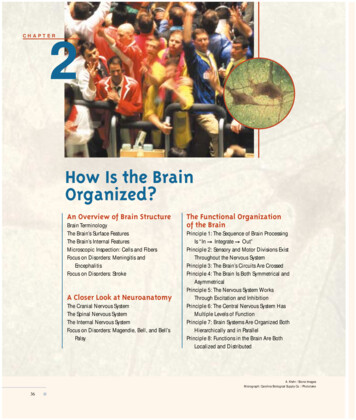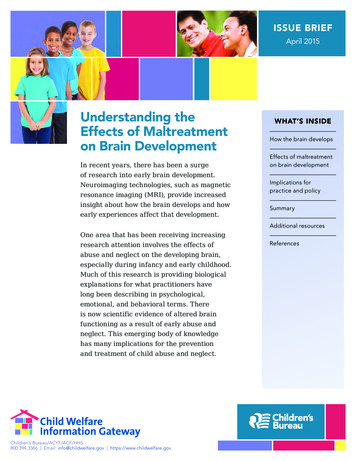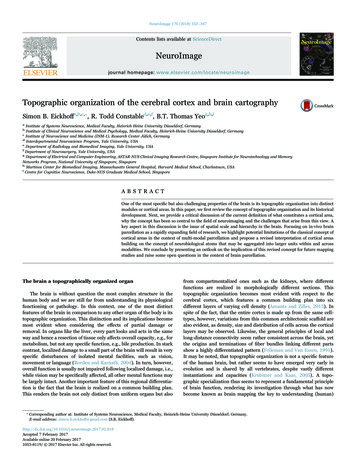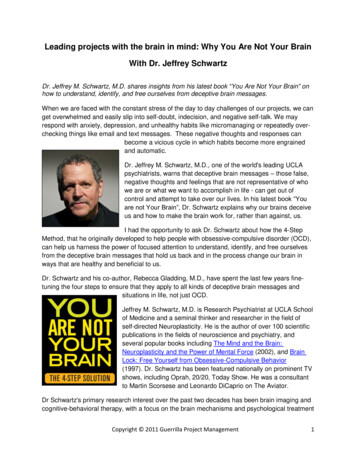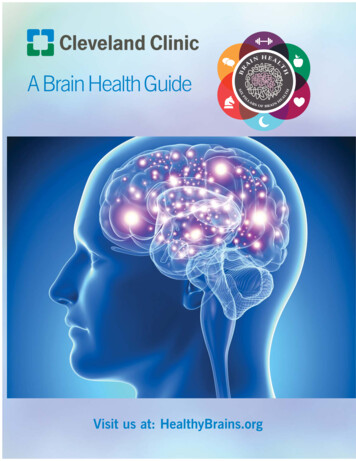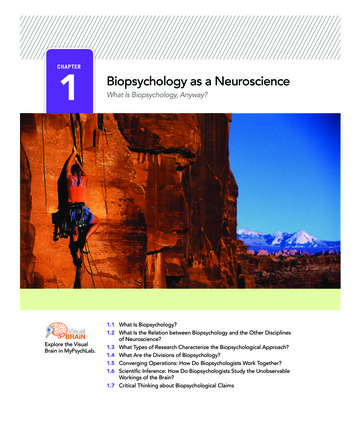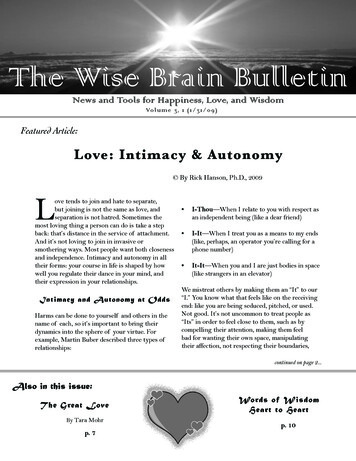
Transcription
The Wise Brain BulletinNews and Tools for Happiness, Love, and WisdomVolume 3, 1 (1/31/09 )Featured Article:Love: Intimacy & Autonomy By Rick Hanson, Ph.D., 2009Love tends to join and hate to separate,but joining is not the same as love, andseparation is not hatred. Sometimes themost loving thing a person can do is take a stepback: that’s distance in the service of attachment.And it’s not loving to join in invasive orsmothering ways. Most people want both closenessand independence. Intimacy and autonomy in alltheir forms: your course in life is shaped by howwell you regulate their dance in your mind, andtheir expression in your relationships.Intimacy and Autonomy at OddsHarms can be done to yourself and others in thename of each, so it’s important to bring theirdynamics into the sphere of your virtue. Forexample, Martin Buber described three types ofrelationships: I-Thou—When I relate to you with respect asan independent being (like a dear friend) I-It—When I treat you as a means to my ends(like, perhaps, an operator you’re calling for aphone number) It-It—When you and I are just bodies in space(like strangers in an elevator)We mistreat others by making them an “It” to our“I.” You know what that feels like on the receivingend: like you are being seduced, pitched, or used.Not good. It’s not uncommon to treat people as“Its” in order to feel close to them, such as bycompelling their attention, making them feelbad for wanting their own space, manipulatingtheir affection, not respecting their boundaries,continued on page 2.Also in this issue:T he Great LoveBy Tara Mohrp. 7Words of WisdomHeart to Heartp. 10
continued from page 1.or in the extreme, some kinds of sexual abuse.And certainly common to treat people as “Its”to make it easier to act freely: examples includedumping negative emotions without caring aboutthe impacts, trampling on people to get ahead, orsimply cutting in line.Intimacy and AutonomyWorking TogetherOn the other hand, intimacy and autonomyare channels for expressing your naturalgoodness. For example, being kindtoward someone naturally involves both an affinitywith that person and a certain autonomy forthe kindness to be genuine. Besides its obviousrewards in everyday life, intimacy supportspersonal growth and spiritual practice throughbringing you into relationship with things. Intorelationship with your innermost experienceand that of the people around you: the joys andsorrows, the suffering and its causes and whatleads to its ending. Into compassion, kindness,and service: Love thy neighbor as thyself. Intorelationship with a supportive community.And—if it’s meaningful to you—into relationshipwith God. Autonomy, too, supports personalgrowth and spiritual practice. For example, inGreetingsThe Wise Brain Bulletin offers skillful means frombrain science and contemplative practice—to nurtureyour brain for the benefit of yourself and everyoneyou touch.The Bulletin is offered freely, and you are welcome toshare it with others. Past issues are archived atwww.WiseBrain.org.Rick Hanson, PhD and Richard Mendius, MD editthe Bulletin, and it’s designed and laid out byBrad Reynolds at BradleyYes@aol.com.To subscribe, please contact Rick at drrh@comcast.net.Buddhism, you are supposed to “see for yourself ”and make your own decisions about what makessense to you. It is up to you, and no one else, toengage the path of awakening. It is you who willinherit the results of your actions, good or bad.Intimacy and autonomy are often seen as oppositeends of the same continuum, so that as oneincreases the other diminishes (see Figure 1). Theclassic example is, “Getting married means givingup my independence.” Less dramatically, peoplehave understandable fears that if they expresstheir deepest truth, others will leave them – or ifthey get really close emotionally, they’ll lose someof their own identity.INTIMACYAUTONOMYFigure 1But intimacy need not undermine autonomy,and vice versa; in fact, they support each other.Intimacy fosters autonomy since repeatedexperiences of caring connection, particularlyin childhood, are critical for the developmentof normal ego functions, personal worth, andconfidence; healthy relationships provide the“secure base” from which we engage the worldas an individual. Autonomy – both yours and theother person’s – nurtures intimacy in many ways,including its reassurance that you can still protectyourself when you’re wide open to another person,and by giving an extra oomph to relatedness: itmakes such a difference when you know that theother person really wants to be with you.Patterns of Closenessand IndependenceActually, intimacy and autonomy are independentdimensions, and it is their combination that counts,as you can see in Figure 2.High I and High AHigh I and Low ALow I and High ALow I and low AIntegratedEngulfedIsolatedAdriftFigure 2continued on next page.Wise Brain Bulletin (3.1) 1/09 page 2
The qualities in each quadrant, imperfectlysummarized by the single word inside, characterizeboth types of individuals and, more importantly,states of mind we all transit: Integrated—Comfortable and skillful withboth closeness and agency; able both to carryothers in her heart while pursuing her ownaims, and to be completely authentic in themost intimate moments; symbolically, “you”and “I” are about the same size. Engulfed—Highly connected, but not free toact or express himself fully; giving up “me”is price to be “we;” unnecessarily dependent;clutching, beseeching, placating; could resistencouragement to be more independent; “you”are big and “I” am small. Isolated—Strong sense of personal desiresbut weak connections with others; a solitarycaptain with a firm hand on the rudder; couldbe prickly about bids for closeness or seeminginfringements on her prerogatives; “you” aresmall and “I” am big. Adrift—Dissociated from both others andoneself; unresponsive and passive ; alone in aboat with no direction; “you” are small and “I”am small. Concern—It will be unwanted; it will lead tocriticism, anger, punishment, abandonment;“I’ll look bad” Defense— Silence, suppression, denial,vagueness, intellectualization (e.g., describingan emotion in a very detached way),distraction, compromise (e.g., bickering as away to connect and distance at the same time),changing the subjectMuch of the time, the Concern and Defensereactions happen so quickly—often in less thana second – that they’re hardly noticed. Yet theyroutinely filter, twist, or suppress a person’sexpression of his or her true self. The result is apolite mask, a persona, that is not a lie but is farfrom the full truth. When two people communicatethis way, it becomes a relatively distantrelationship: it could have consideration and goodbehavior, but not much emotional intimacy.Of these four, the Integrated mode of beingclearly brings the most benefits to you and toothers, it is the best foundation for personalgrowth and spiritual practice, and it involves themost complex forms of neural regulation. To feelsafe in the deep end of the pool of intimacy, aperson needs to be able to speak her own truth andbe comfortable with closeness – so let’s start there.IAuthentic Self-Expressionmagine telling someone in an importantrelationship that you feel let down, or needto apologize, or feel angry, or want to getemotionally or physically closer.Did you have any reactions inside when youimagined saying those things?In the mind, there is a typical sequence: Expression —An emotion, desire, opinion,actionIn many real-world situations, concerns about fullexpression are warranted; most business meetingsare not places to spill your guts, certain peoplewill mis-use what you tell them, and sometimeswe know there’s no point in disturbing the peacewith a parent or other relative. But even whenthe manner and content of what you have tosay are truly fine, inhibitions from previous lifeexperiences, particularly in childhood, createbottlenecks for self-expression.Wise Brain Bulletin (3.1) 1/09 page 3continued on next page.
T he Impact of ExperiencesChildren express what they feel and whatthey want through their actions, emotions,signals, and, by their second birthday,words. Then people respond, including theirparents, teachers, and other children; responsescan be active or passive, verbal or nonverbal,positive or negative. These interactive episodesare usually brief, so there are a lot of themeach day. For example, from multiple studies, areasonable estimate is that a typical toddler hashis or her wants thwarted about twenty times anhour, or an average of once every three minutes.Whether it’s called for or not, each thwarting is acommunication, a message, to the child: “No.” Thenthere are other messages: parents who come to afussing baby in the middle of the night, children atschool who let a new kid into their group, peoplewho listen when you’re upset: “Yes.” Added to yourpersonal experiences are the ones you witnessed:what happened when your siblings (if you hadany) expressed themselves, and other children, andadults – and characters, real or fictional, in books,movies, and other media.This learning about self-expression continues intoadulthood and to this day. Throughout it, yourbrain’s negativity bias has highlighted episodeswhen self-expression led to painful feelings. Thepain could be quite subtle, like mild dismay when aperson’s eyes wander away while you’re speaking,or quite intense, like being spanked for mouthingoff at a parent. In neural networks, the types ofself-expression that led to pain became quicklyassociated with fear, and then with rewards likerelief when you learned to inhibit them.TInhibition Profileshe inhibition profile of a particular personcan be quite nuanced. For example, interms of attachment theory, a personraised by a “dismissing” parent could worry aboutasking too much of others, and someone with an“inconsistent” parent—alternately intrusive andrejecting—could feel ashamed or guilty aboutdesires that differ from those of her partner. Or, asa generalization, boys are socialized not to showfear, girls not to show anger; since what people donot express tends to build up inside, I’ve counseledrelationships in which the man is anxious aboutthe woman, and she’s irritated with him. I’ve alsoworked with people who: Can express “armored” emotions like anger butnot more vulnerable ones like hurt or sadness Cannot say “no,” so their “yes” doesn’t meanmuch. Think they are not allowed to say what theyreally want. Feel tongue-tied around authority figures. Get really upset with themselves at the leastanger toward their spouse. Feel that acknowledging problems with aspiritual teacher would be disloyal.These are completely normal inhibitions. Forexample, I sweated for about half an hour beforecontinued on next page.Wise Brain Bulletin (3.1) 1/09 page 4
I finally told a girl—for the first time in my life—that I loved her.What about you? What’s your own history, relatedto self-expression? What do you find easy to say—or hard?Helping Yourself SpeakYour TruthNormal as they are, these inhibitions limityour autonomy, and consequently, yourintimacy. Their regulation is excessiveand thus unskillful. And they harm others bydenying them important information about howyou are feeling and what you really care about.Here are some ways to deal with them:1. Draw on the slow but powerful prefrontalcortex to keep reminding yourself that you areentitled to the pursuit of your own happiness, toyour own experience, and your own view—andthat you will communicate in a virtuous manner.It could help to write out a kind of manifesto—usually for your eyes alone—declaring what is fairand just for you in your relationships. In actualconversations, particularly if they are over thephone or via email or texting, you could set yourmanifesto, or even just a few jotted notes, in frontof yourself. The clarity in explicit language is akind of secure base that establishes the moral,principled rationale for your self-expression.2. Similarly, remind yourself that you areresponsible for conducting yourself in anhonorable way, but not for all the other thingsaffecting a person’s reactions to you. There are10,000 causes upstream of this moment in thatperson’s life that are not wearing your nametag.Fundamentally, each of us is responsible to ourreactions to stimuli – including the person withwhom you’re communicating. Just because heor she feels bad does not in itself mean thatyou did anything wrong. In fact, you could behelping a person by bringing something tolight that, unfortunately, also makes him or heruncomfortable.3. Keep exploring your experience. Think ofit as a multi-track song, the major tracks beingperceptions, body sensations, emotions, thoughts,images, and wants. Particularly sense into thetracks you’re least aware of. Even if you feel out oftouch with yourself at first, continuing to gentlyinvestigate your inner world and treating what youfind with curiosity and kindness, will forge neuralconnections and increasingly bring unconsciousmaterial into awareness. I once did a stint ofJungian dream therapy with a wonderful analystwho had this saying: “When your unconsciousknows you’re listening to it, it’ll start talking toyou.” (The important exception to this generaladvice is for people with a trauma history, whoare advised to steer clear of painful material untilthey’re really ready to go there.)4. Consider how your upbringing, gender,culture, and life experiences have shaped yourcommunication style. Sense their impact in yourbody, in body sensations, constriction of breath,posture, shoulders hunched forward protectively,etc. For example, for a long time my feelings wereblocked by a kind of valve in my throat; I knewwhat they were but just couldn’t get them throughthat choke point. Awareness alone often slowlydissolves these patterns. Additionally, there areformal methods for opening up self-expression,such as bioenergetics, psychodrama, counseling,and somatic experiencing.5. Off-line, not in the moment with the otherperson, practice expressing the things that youusually avoid. Write and say sentences out loud (byyourself) that would be tough to express directly,such as “I feel really needy” or “I’m very angrywith you.” Yes, it’s artificial and theatrical, butyou could also act out certain strong feelings justcontinued on next page.Wise Brain Bulletin (3.1) 1/09 page 5
to break the logjam around them – what bodyoriented therapists refer to as “armoring” – suchas by venting loudly in suitable situations. Until Idid an “anger release” workshop in my 20’s, it wasnearly impossible for me to express that emotion,but just one day of role-playing and a fair amountof yelling cracked open that capability.It’s not just the “negative” emotions that are lockedup; often the biggest undelivered communicationis “I love you.” Here’s another quick story from my20’s. I was getting Rolfed, a form off deep-tissuebodywork that back then was routinely painful,and in the hands of my particular no-mercy Rolfersometimes actually led to rising screams comingfrom her office as I fidgeted in the waiting room:“Stop, Myra, please stop, oh God, please stop!” SoI anticipated the fifth session in the series withdread, since it plunged into the abdomen, where Ifigured buckets of tears were buried. But when shegot in there, an incredible wave of love poured out,which had been suppressed for many years.In your mind or on paper, make a list of yourmajor undelivered communications, past andpresent. Be sure to include positive emotionsand statements which haven’t been expressed.Then decide what you want to do with this list. Itwill be too late or inappropriate to deliver somecommunications directly, though you can stillexperience a lot of benefit from saying them outloud or writing them in a letter that does not getsent. For the rest, it could be good to get them offyour chest!Methods like these can really help youcommunicate autonomously – and thus help youconnect intimately.Wise Brain Bulletin (3.1) 1/09 page 6
The Great Love By Tara Mohr, 2009Something remarkable happened to me thisyear: I started loving everyone. Everyone.The hundreds of people I know and thebillions I don’t.I’m not sure exactly when I began lovingeverybody, but I do know when I first realized it: Iwas writing a short bio for my website. I composeda sentence or two about my work and family--theusual stuff. And then what I really wanted to saypopped into my mind: My heart is full of love foryou.My inner critic quickly joined this party: “Thatis not a normal thing to put in a bio,” it warned.“That’s ridiculous. In fact, it is dangerous! Youcannot tell strangers on the internet that you lovethem!”But something in me persisted: this was important;that this was the truth of me at this moment. Thebio would be incomplete without those words. Andso I typed in the last line: “Her heart is brimmingfull of love for you.”reason: it stems from a profound knowing thateverything is divine and worthy of love, that thebasic nature of everything is good.The Great Love is beyond what we canconceptualize or hold in this lifetime, but when weexperience even little shards of it, whispers of it,we are filled with something so huge and powerfulthat we are opened, flattened, transformed.Those little shards show up for most of us inmomentary, profound experiences – perhaps whenwe are in nature, when we experience a pieceof art, when we look into a newborn’s eyes. Formany of us they show up at moments all togetherunexpected--staring out the car window at a redlight, cutting tomatoes at the kitchen counter,peddling along on the bike at the gym. Withspiritual practice, which is consciously connectingto The Great Love itself, we can become a morefrequent channel, a more receptive vessel, for TheGreat Love.It struck me, how odd and powerful this was: Ihad no idea who would be reading those words onmy website, what those individuals believed, whatgrievous acts they might have committed or whathatreds they harbored for others, but I was entirelysure I loved them, and I loved them wholly anddeeply.That was the beginning of--or maybe a return to-a feeling of loving everyone. That was a momentof transition of becoming a more open channel forwhat I’ll call The Great Love.Love, as we define it in our culture, is personal,selective, based on direct contact or experiencewith a person or thing. It is conditional, based onparticular qualities or actions of that person orthing.The little shards of The Great Love, thethreads, the whispers, come into my heartoften now. When I watch the news orthink of a country around the world, I do so withan underlying feeling of great love and kinshiptoward every person in it, including the “bad guys”and the dictatorial leaders.The Great Love is not selective; it is allencompassing. It is unconditional, but not withoutWise Brain Bulletin (3.1) 1/09 page 7continued on next page.
When I walk down the street, I feel so proud ofand awed by each person I pass. I keep my mouthshut (haven’t broken that social convention yet),but I so strongly want to affirm them for just beinghere, existing. I want tell them how unique andgorgeous and powerful they are walking down thestreet. I often do so in my mind.And when I look out my twentieth floor windowsat the long twisting tail of traffic on the highway,or the checker box windows of the neighboringskyscrapers, I feel a tidal wave of good will. I feelhow hard each person is trying to get the loveand acceptance and stability that we all want inlife. I want them all to be showered with a rain ofblessings and struck with lightning hope. Aboveall, I want them to be good to themselves, toextend to themselves the forgiveness and lovingkindness they deserve. I don’t know these people,but I know their hearts.IT he Great Love – Part IIf you become a more frequent channel for TheGreat Love, it will bless all those around you.But it will also aid you, in ways practical andprofound:1. Life gets easier. The Great Love makes everyinteraction smoother and lighter: paying thebridge toll, taking a difficult phone call at work,tackling the to do list. Those kinds of tasks canget clunky, draining. Doing them with The GreatLove is the difference between driving in trafficand riding a magic carpet in the sky.2. Fear dissolves. Love and fear are all-consumingstates of mind; they cannot co-exist within us atthe same moment. This is big news; this is our wayout of fear. If, when I am at a party or a meetingfor work, I am in contact with The Great Love, myinsecurities simply aren’t with me. The material inmy brain is literally unable to receive or processnegative thoughts.3. You walk through life wrapped in the blanketof The Great Love. The Great Love is the allencompassing, unconditional love for all ofCreation. It is impossible to feel The Great Lovefor others and not for yourself. Being a channel forThe Great Love is receiving The Great Love foryourself is emanating The Great Love for others.As you walk through life wrapped in the warm,protective blanket of The Great Love, the worldbecomes safer, because your insane thoughtshave been replaced with the sane truths of love,compassion, and calm appreciation for each humanbeing on earth.4. You become a magnet, in the nicest way. I knowthat “big” isn’t the most writerly word, but I don’tknow any way to say it better than this: The GreatLove is big, and when you become a conduit forit, you become very big. You walk into the roombigger, you exist bigger, the contours of your lifegrow larger. People turn around when you enter aspace. People want to go your way with things. Youare empowered to say more and act more boldlybecause you know your words and ideas aren’t justcoming from you, but from something very big andintelligent and true. You operate with a confidence,humor and calm that draws others toward you andcauses them to want to work with you. And whenthey don’t, you don’t take it personally. I promiseyou that you will see these effects in your life.5. Most importantly, you see the truth. Keatswrote, “Beauty is truth and truth, beauty.” Whenyou are in The Great Love and The Great Loveis in you, it is as if a light snow has fallen oneverything and that snow is the dust of miracles,the tinge of stunning beauty. It is as if the mostwell-crafted, moving, beautiful play ever written isbeing played out in your daily life. The Great Loveis the opera glasses that allow us to witness it.How do you put those opera glasses on?There are more ways than there are human beingson earth. We are in no shortage of ways for eachof us to open to more love.continued on next page.Wise Brain Bulletin (3.1) 1/09 page 8
The most important one is this: Ask. Ask God,spirit, the universe, the power of creation to makeyou a channel of The Great Love. Ask your innerwisdom what you need to do to become a greaterchannel for it. In any situation, take your focus offthe whirling world around you and turn inwardfor a few moments. Ask The Great Love to enterthe situation, through you, through others and inthe space itself. And here are some other ways toaccess The Great Love:Invite the Great Love In:End the separation between you and the rest ofhumanity. Realize that, since birth, you’ve beentrained by our culture to believe in separation.You’ve been schooled that some people are betterthan or worse than others, that some people arefundamentally good and others evil. I know thatyou can’t just let go of these thoughts. They haveto let go of you. You need to replace them withnew ideas.Bring More Love Into The Ecosystem of You:Find out how you are withholding love fromyourself, and work toward stopping that unjust act.Probe your destructive, self-harming beliefsBring love into your heart and your body by livingyour passions.Be of service. In any situation, ask yourself, theuniverse, or the people around you how you canbest be of service. Do as many acts of kindness asyou can. Give generously of your time, money, andpossessions. All of this will bring more love intoyou.Love the People in Your Midst:Decide that everyone around you is perfect as theyare and holds 100 miraculous gifts. Start keeping alist of them. Appreciate them out loud.Every day, give ten authentic compliments tostrangers or to people you know.Study forgiveness and work toward forgiving thepeople toward whom you are harboring anger,resentment, hurt and hate.Grapple the idea everything is either an expressionof love or a call for love. Hold this thought andlook for evidence to support it.Believe that everyone is trying as hard as you.Hold this thought and look for evidence to supportit.Believe that everyone wants the things youwant: belonging, acceptance, to be heard, to feelcompetent, accepted, to matter. Hold this thoughtand look for evidence to support it.There are millions more ways to access The GreatLove, and the ones that are personal to you willbe the ones that are most powerful for you. If youask The Great Love what you need to do to bringmore love into you today, it will answer you. If youinvite The Great Love in, it will visit. If you giveyour problems to it, it will not let you down.Go play with all of this and discover, and let meknow what you learn.Author BioTara Mohr is a writer, life coach and programofficer at a bay area community foundation. Toread more of Tara’s writing on the spiritual lifeand on living life with greater attention, visit herblog, Bountiful Heart at http://sophiashouse.wordpress.com.Wise Brain Bulletin (3.1) 1/09 page 9
Wo r d s o f W i s d o mHeart to HeartBe kind, for everyone you meet is fighting a hard battle. PlatoI believe we can change the world if we startlistening to one another again. Simple, honest, humanconversation. Not mediation, negotiation, problem–solving, debate, or public meetings. Simple, truthfulconversation where we each have a chance to speak,we each feel heard, and we each listen well. Margaret J. WheatleyEverything that counts cannot necessarily be counted. Albert EinsteinWhat we need is what the ancient Israelites calledhochma - the science of the heart - the capacity to see,to feel, and then to act as if the future depended onyou. Believe me, it does. Bill Moyers[A proper teacher is] the one person who . . . ‘isalways on our side’ -- the one who is motivated notby self-aggrandizement or a wish to be veneratedbut by the wish for the liberation and freedom of thestudent. . . . The teacher does not exist to be admiredby us but to point us back to our innate nature. Sharon SalzbergRemember not only to say the right thing in the rightplace, but far more difficult still, to leave unsaid thewrong thing at the tempting moment. Winston ChurchillThe happiest hours of my life have been spent in theflow of affection among friends. Thomas JeffersonThe more deeply you understand other people, themore you will appreciate them, the more reverent youwill feel about them. To touch the soul of anotherhuman being is to walk on holy ground. Stephen R. CoveySan Rafael Meditation GroupOpen to beginners and experienced practitioners, we meet on Wednesday evenings at the A Sante dayspa in downtown San Rafael at the corner of Brooks and 3rd. “Early-bird” meditation starts at 6:45with formal instruction at 7:00; meditation ends at 7:30, followed by a brief break, and then a dharmatalk and discussion, ending at 8:30. It is led by Rick Hanson, and for more information, check outwww.WiseBrain.org/sanrefaelmeditation.html. Newcomers are always welcome!Wise Brain Bulletin (3.1) 1/09 page 10
From Our Readers. Poem by Tom Bowlin, 2008NoticedMy motherNever noticedPhoto credit: Wayne Miller, U.S.A.How muchI love herWise Brain Bulletin (3.1) 1/09 page 11
Grateful WonderThere’s just something about bubbles that makes people happy. Here are some really good ones – someof them light-years across! It’s remarkable to contemplate coherent structures that are that large . . . Bubble basics: http://en.wikipedia.org/wiki/Soap bubble The Bubble Nebula (10 light-years across): http://antwrp.gsfc.nasa.gov/apod/ap090124.html A bubble in Cygnus: http://antwrp.gsfc.nasa.gov/apod/ap081113.html From the supernova of 1006 (60 light-years across): http://antwrp.gsfc.nasa.gov/apod/ap080704.html Left over from a supernova (150 light-years across): http://antwrp.gsfc.nasa.gov/apod/ap090131.html The Homunculus Nebula: http://antwrp.gsfc.nasa.gov/apod/ap080617.html The Fetus Nebula: http://antwrp.gsfc.nasa.gov/apod/ap080825.html The Crescent Nebula (25 light-years across): http://antwrp.gsfc.nasa.gov/apod/ap080813.html And my favorite, just called The Bubble: http://apod.nasa.gov/apod/ap061018.htmlWise Brain Bulletin (3.1) 1/09 page 12
OfferingsRick Hanson, PhD, and Rick Mendius, MD1. Sounds True offers Meditations for Happiness by Rick Hanson, Ph.D. It’s 3 CD’s worth of talks and brainsavvy exercises for increasing your happiness, with an emphasis on experiential practices and practical tools.It is offered as an inexpensive download to your computer, where you can listen to it or burn it to CD’s ortransfer it to an iPod.This program truly turned out to be pretty great, and here’s a comment about it from the author, AnnieSpiegelman:On his new “Meditations for Happiness” program, benevolent Rick Hanson guides me to sit down and face my innercritic – and then actually see it as a form and shrink it. Being a Master Gardener, I see the critic as a gnome who tiptoesinto my brain when no one is looking, with those tiny pointy shoes, and makes me doubt myself. I shrink him down to thesize of a snail and toss him out. He knows nothing. The shoes are a dead giveaway.Here’s the link to this program at Sounds True: ectProd.do;jsessionid AA644B8B2BA5A2526E297913DE0434AD?prodId 1715&manufacturer Sounds%20True&category Exploring%20the%20Psyche&name Meditations%20for%20Happiness2. Rick also has a chapter, “7 Facts about the Br
Intimacy and Autonomy Working Together O n the other hand, intimacy and autonomy are channels for expressing your natural goodness. For example, being kind toward someone naturally involves both an affinity with that person and a certain autonomy for the kindness to be genuine. Besides its obvious rew






